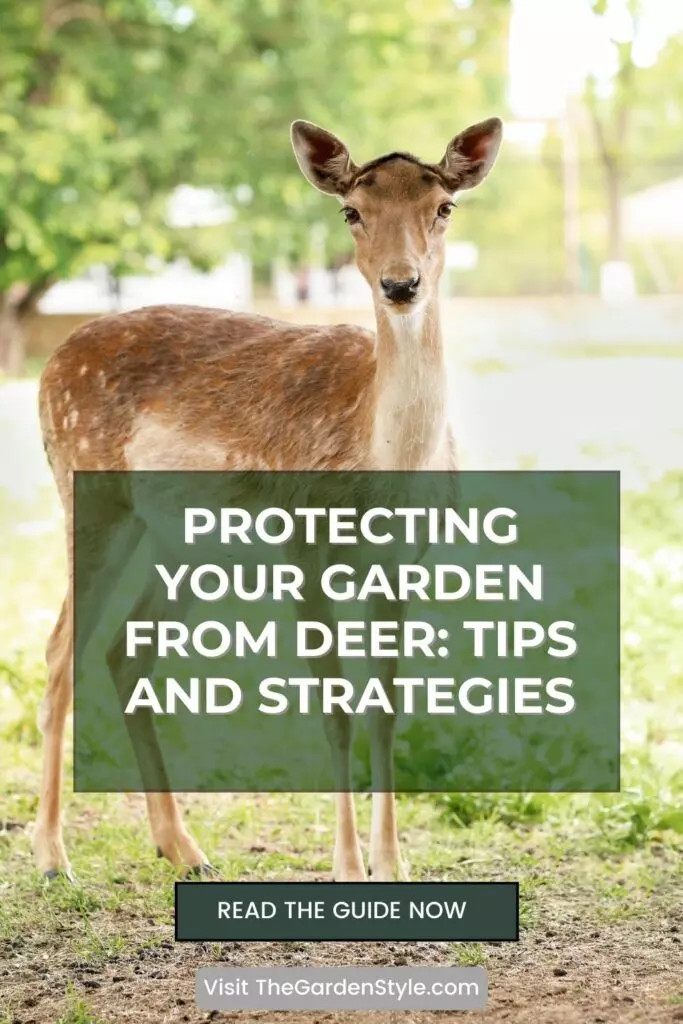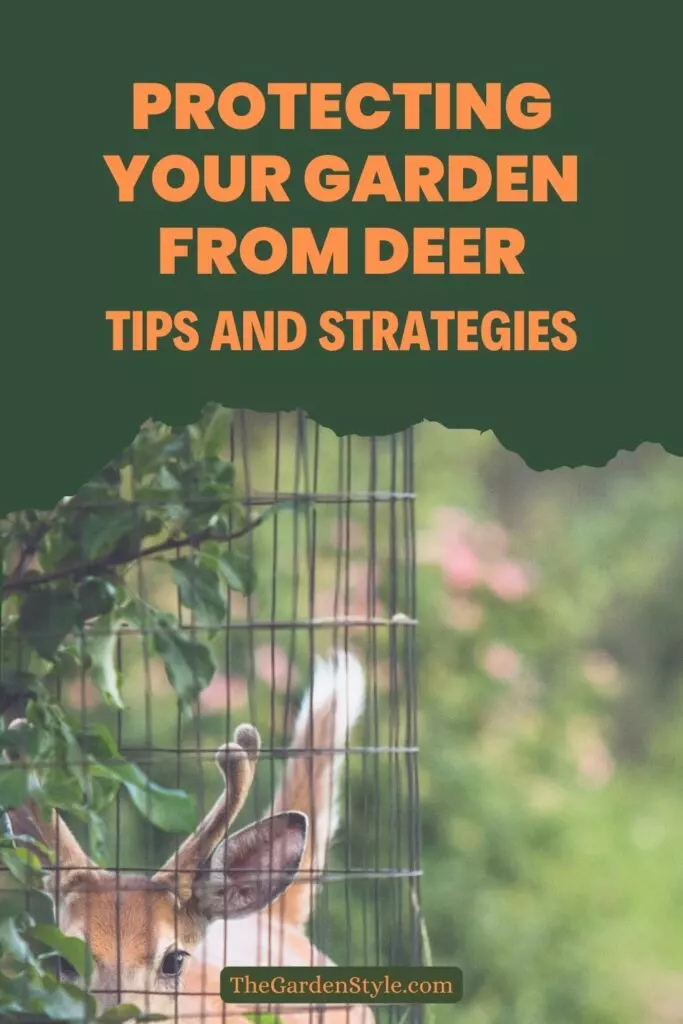Deer can wreak havoc on gardens by feeding on many types of flowers, plants, and vegetables. Their appetite, combined with a lack of natural predators near many suburban homes, creates ample opportunities for them to raid gardens. This leads to disappointment and frustration for gardeners who have invested time, money, and care into their garden plots. Protecting your garden flowers and vegetable garden is crucial to prevent deer from munching away all your hard work overnight. In this post, we summarize useful gardener’s tips and strategies to make your garden as deer-resistant as possible. Proper fencing, repellents, and landscaping choices can help deter deer and avoid scenarios where your garden gets completely demolished by these sneaky creatures. Let’s start.
Table of Contents
Deer-Resistant Plants and Garden Design
When thinking about the garden design and its landscaping, one of the easiest ways to discourage deer is by selecting plants that deer tend to avoid and creating a layout that prevents deer from reaching what you want to save the most.
Choosing Deer-Resistant Plants
Deer have preferences for certain types of vegetation, so planting species that are less palatable or appealing to them from the start will minimize temptation. Also, the strong scents can act as a natural deer deterrent. The right plant choices can make a big difference.
Some deer-resistant options include:
- Ornamental grasses like purple fountain grass, maiden grass, and Japanese silver grass
- Lavenders
- Daffodils
- Bee Balm
- Peony
- Iris
- Alliums
- Sages
- Rosemary
- Euphorbias
Many plants are called deer-resistant because the smell may deer away, but also, the plant’s texture is important to repel deer. Plants with fuzzy or spiky leaves are definitely unpleasant for deer, and a first line of these plants will discourage them from moving into your garden.
Recommended articles:
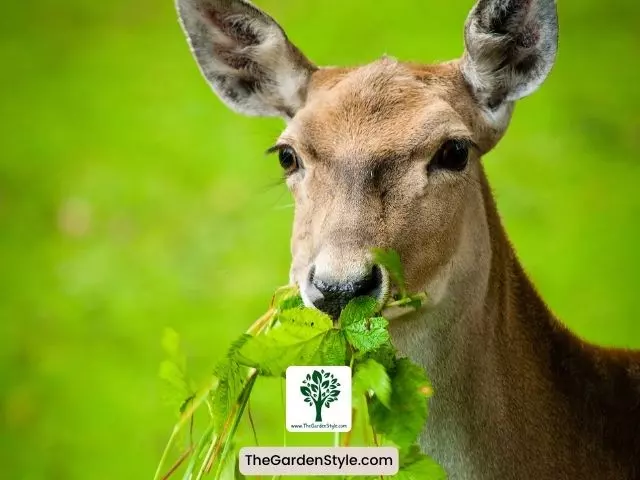
Anticipating a Deer-Resistant Garden Design
We live in an area crowded by deer, close to a National Park, so deer are everyday guests. However, there are two things gardeners should think about ahead of time when designing their flower and vegetable gardens to discourage deer.
First, place water sources away from the garden and the main planting areas to minimize deer attraction to your garden. Deer are naturally drawn to water. This simple adjustment in layout can contribute to a more effective deer-resistant garden design, reducing the likelihood of deer-related damage to your plants and creating a less enticing environment for these animals.
Second, plant clusters of deer-resistant plants, all together, like “tiny islands” in your garden to protect what is most precious to you. In these “safe zones,” you group plants that deer typically dislike, which forms a natural deterrent, safeguarding more vulnerable species within these concentrated areas.
It is not only about the smell. Many of these deer-resistant plants have an unpleasant texture for deer. Choose plants with textures that deer find unpleasant, such as fuzzy or spiky leaves, as the first line of defense.
Incorporate several of these deer-resistant plants together in the same garden bed for the best effect.
You can also use them to border more vulnerable flower beds or vegetables to act as a deterrent to deer approaching those areas. Having a diversity of plants that deer do not prefer surrounding your most precious garden investments offers natural protection.
Third, use deer-resistant mulch. Certain types of mulch, such as pine straw or cedar mulch, are less appealing to deer. Consider using these around vulnerable plants.
Fencing and Garden Layout
Installing a tall fence around your garden is the most reliable way to keep deer entirely out of your landscape. A properly constructed fence provides a physical barrier that deer will not attempt to cross.
When installing a deer fence, you’ll want to use strong material such as welded wire or woven wire at least 8 feet tall. Some things to keep in mind are:
- Place the fence posts closely enough to keep the fence taut.
- Bury the bottom portion underground to prevent deer from crawling underneath.
- Angle fence outward about 3 feet across the top to prevent deer from jumping over.
- Ensure there are no gaps in the fencing larger than 6 inches wide.
In terms of layout, positioning the vegetable garden closer to the house makes it easier to monitor and access frequently. Deer also tend to be warier approaching as they get closer to human activity.
You can also use walls, sheds, or tall plantings of hedges/trees to block potential deer paths to the garden, funneling them towards other directions. Design the landscape so their easiest routes do not pass through the garden.
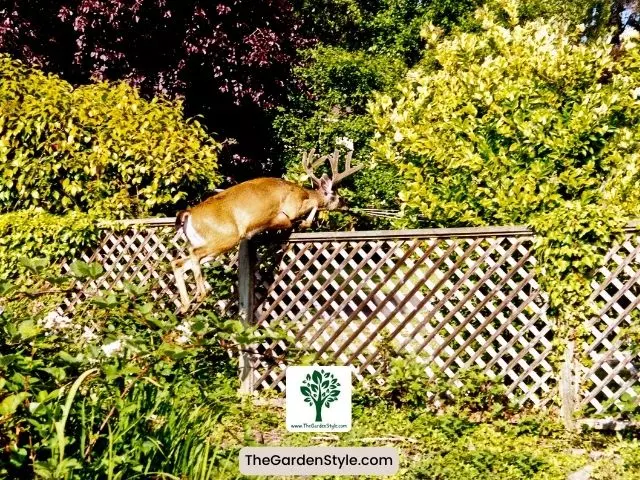
Scare Tactics and Deer Repellents
Enhancing your garden’s resilience against deer involves deploying effective scare tactics and repellents. From visual deterrents like reflective wind chimes to auditory measures with motion-activated sprinklers and scent-based repellents utilizing natural formulations, this guide explores diverse strategies. Persistence and consistency are vital in creating a deer-resistant haven for your garden.
Visual Deterrents
In addition to fencing and plant choices, using various visual scare tactics can make your garden less appealing for deer. Seeing unfamiliar and scary objects can frighten deer away.
Placing traditional or high-tech scarecrows, wind chimes with reflective surfaces, or metallic flashing tape around gardens creates movement and reflections that startle deer. Hanging old CDs or metallic pie pans that move in the breeze also deter deer once they discover them.
Garden flags or streamers placed intermittently through border plantings create a sense of human presence. These are most effective when moved periodically to new locations and swapped out for variety.
The key with visual scare tactics is to employ a diversity of objects and change their positions every 2-3 weeks for maximum effect. Any method requires persistence to remind the deer this is not a comfortable eating spot. But these creative tools provide natural ways to establish your garden as an annoying habitat for deer to avoid!
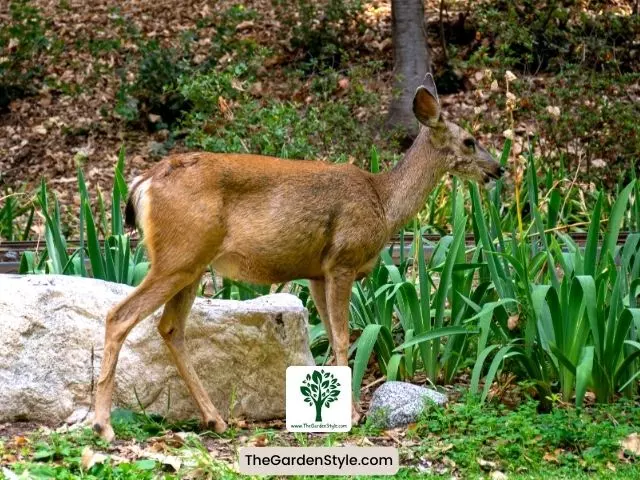
Auditory Deterrents
Deer also dislike loud noises or sounds they don’t recognize. Taking advantage of their keen sense of hearing is another creative way to discourage them.
Placing wind chimes, tin pie pans, or other noisemakers at garden entry points alerts deer of your space and makes them wary. Deer tend to avoid noisy, unpredictable areas in favor of quieter grazing territory.
Motion-activated sprinklers that emit clanging sounds when triggered by movement are very effective. Position them wherever deer tend to approach, and the sound will drive them back immediately once activated, training them to avoid that area altogether eventually.
When placing auditory deterrents, ensure you have coverage around the entire vegetable garden or vulnerable flowers. The devices should be moved around the perimeter every couple of weeks for maximum benefit, as deer can become used to constant sounds.
Scent-Based Repellents
Certain strong scents can also deter deer from grazing in your garden beds. Scent repellents create odors that are unpleasant or alarming to deer.
Natural formulations like predator urine (coyote, wolf) or human hair contain threatening smells that signal danger to deer. These bottled repellents should be reapplied around vulnerable garden perimeter areas every 2-3 weeks.
Homemade repellent sprays typically contain eggs, hot peppers, garlic, soap, or other pungent ingredients. An effective concoction is:
- 3 eggs
- 1 gallon of water
- 3 oz hot sauce
- 1 bulb of chopped garlic
- 1 tbsp dish soap
Blend ingredients thoroughly and strain before pouring into a spray bottle. Reapply the liquid repellent after heavy rains or every 2 weeks for best results. Always spray repellents directly onto plants rather than scattering granules.
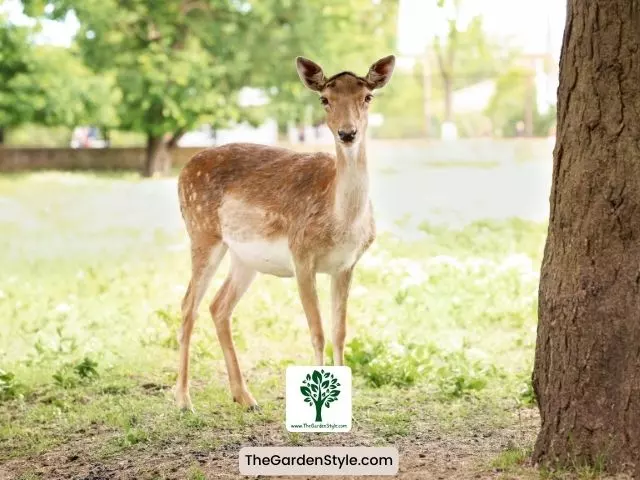
Pet-Safe Methods for Deer Control
Ensuring a deer-resistant garden extends beyond protecting plants to safeguarding your pets. While some deer-repelling plants may be toxic to household animals, this guide provides a list of safe alternatives. Explore pet-friendly options like roses, lavender, fennel, petunias, and marigolds, along with non-toxic repellents for effective and safe deer deterrence.
Safe Plant Choices for Pet Owners
When selecting deer-resistant plants, it’s crucial to ensure they are safe for any household pets. Some plants that discourage deer contain toxic substances if ingested by dogs or cats. Avoid choosing those options if you have pets.
Some pet-friendly options include:
- Roses – Highly unpleasant for deer but safe for pets.
- Lavender – Unappealing smell, plus soft leaves will not harm pets.
- Fennel – Deters deer effectively, and all parts are non-toxic to pets if eaten.
- Marigolds – An unpleasant scent for deer, yet gentle enough if nibbled on by pets.
- Zinnias – Bright and colorful blooms that are non-toxic to pets, making them a safe and cheerful addition to your garden.
Recommended articles:
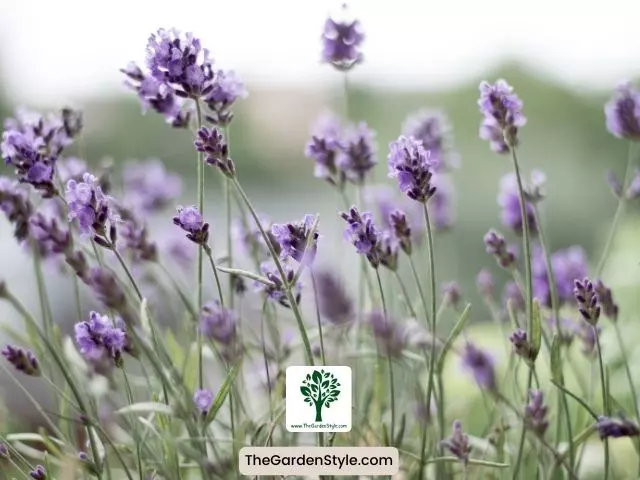
Non-Toxic Repellents
When dealing with both deer and household pets, it’s important to select commercial repellents that are non-toxic for domestic animals. Some options made from natural ingredients will deter deer without harming pets if they spread onto areas your dogs or cats access.
Repellents containing oils from black pepper, garlic, rosemary, thyme, and other cooking herbs are extremely effective against deer yet gentle enough if licked or touched by pets. Brands like Plantskydd use formulations that train deer to avoid treated areas.
When applying these pet-safe repellents, concentrate on plants and the boundaries of the sections you aim to protect from deer. Avoid spreading excessively throughout the rest of your yard space or onto surfaces your pets frequently access. Spot treat the plants specifically vulnerable to deer damage rather than blanket spraying the whole garden.
Long-Term Garden Maintenance
Regular Monitoring and Maintenance
Discouraging deer requires diligence and commitment over time. Keeping up consistent maintenance of your deer defenses avoids falling into a false sense of security should they return.
- Walk the garden perimeter daily checking for gaps in fencing, signs of digging under barriers, and trampled plants which indicate attempted deer entry.
- Examine ornamentals and vegetable plants thoroughly each morning for chewing damage or bite marks. Catching deer infiltration promptly is key before it escalates.
- Assess scent markers and scare tactics weekly to ensure proper placement and function. Solar lights, bells, and deterrent sprays can malfunction or diffuse over time.
- Reapply commercial repellents regularly according to label directions, typically every 1-2 weeks. Natural versions may require increased frequency depending on rainfall.
Staying alert through proactive inspections and upkeep measures will help sustain your robust defenses against recurring deer, ensuring your plants remain protected.
Seasonal Adjustments
Deer foraging patterns and food preferences fluctuate based on seasonal conditions and availability. As the year progresses, maintain awareness of these changes to enhance your deer-proofing tactics.
During fall, enhance precautions as deer become more active in preparing for winter. Add more temporary fencing near tasty fall blooms if needed. The rut and mating season also increases deer movement and boldness at this time.
When your spring garden starts actively growing again, review which new plants and greenery will likely attract deer. Strategically move your scent deterrents closer to emerging flowers and vegetables that deer tend to favor.
In winter, remain vigilant for starving deer who become less cautious of threats. Fortify fences, project noisy scare devices further, and use emergency commercial repellents on dwarfed winter vegetation that appears irresistible.
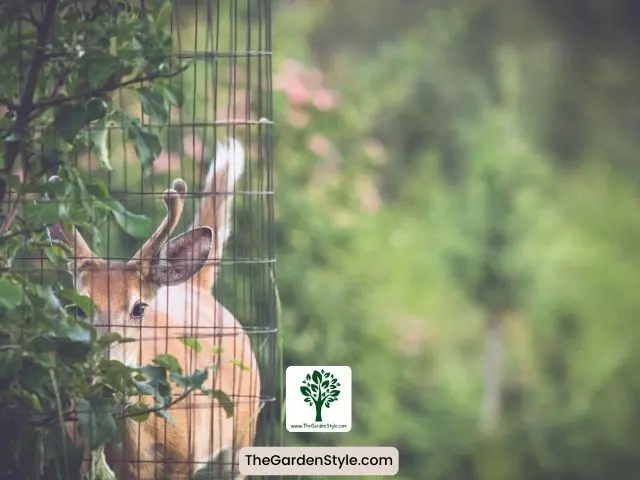
Contingency Plan
If deer breach garden defenses, immediately apply repellents like garlic or predator urine, install taller fencing, or use motion-activated deterrents. Assess plant damage, prune affected areas, and promptly water to aid recovery. Employ netting or covers to shield vulnerable plants. Apply natural remedies like cayenne pepper or soap sprays to deter further grazing. Implement a vigilant inspection routine, reinforcing barriers and maintaining a resilient garden to mitigate future deer intrusions.
Conclusion
Deer can swiftly destroy gardens and undo all your hard work if left unchecked. Protecting your landscape is crucial, no matter how initially deer-proof it may seem. Employing fencing, strategic plant selection, scent deterrents, and scare tactics in combination create a formidable defense that keeps deer at bay for good.
The key is persistence and diligence to maintain defenses, alter placements, and stay alert to seasonal changes in deer behavior. But this vigilance pays off with peace of mind that your garden won’t disappear overnight. Don’t become another victim of deer garden destruction! Follow these research-backed tips to reclaim your space and fully enjoy the fruits of your gardening labor at last.
With some strategic planning and commitment to ongoing maintenance, you can sustain a lush, thriving garden that deer simply avoid. Your new deer-free garden is waiting!
| Aspect | Strategy |
|---|---|
| Deer-Resistant Plants | Choose plants deer avoid; use smelly plants as deterrents; consider lavenders, grasses, daffodils, etc. |
| Texture Deterrents | Use fuzzy, spiky plants |
| Garden Design | Place water away from garden; make deer-resistant plant clusters; use cedar mulch |
| Fences/Layout | 8-ft fencing; angle fence out; place garden near home; block deer paths |
| Companion Planting | Mask smells with herbs; add prickly plants; disguise vulnerable plants |
| Scare Tactics | Startle deer with visual/noise deterrents; use predator scents |
| Pet-Safe Methods | Choose safe plants and natural repellents |
| Maintenance | Monitor defenses; reapply repellents |
| Seasonal Adjustment | Adjust for seasonal foraging; enhance through winter |
| Contingency Plan | Apply repellents if breached; add deterrents; prune damaged plants |
If this post about protecting your garden from deer was helpful, please share it:
